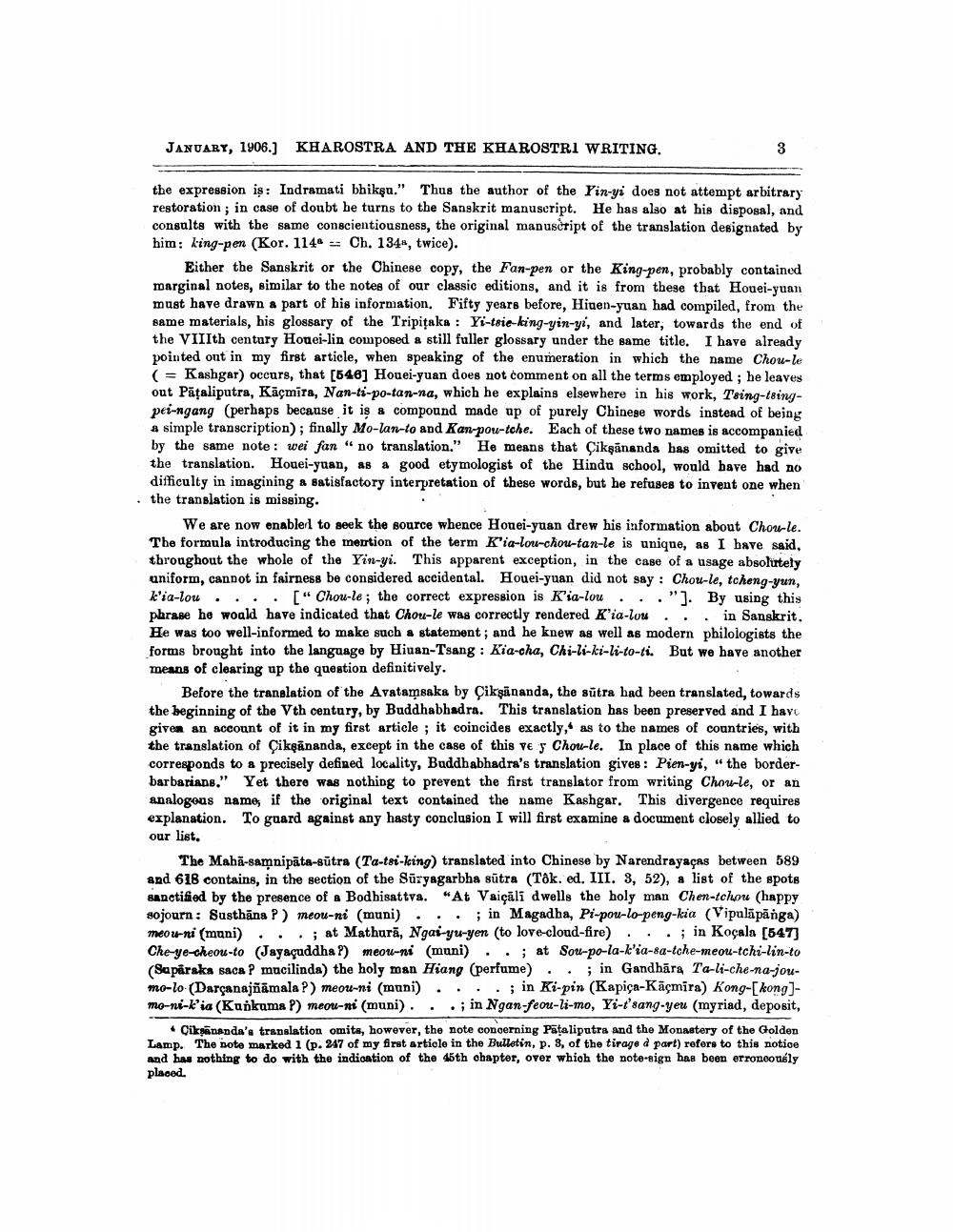Book Title: Indian Antiquary Vol 35 Author(s): Richard Carnac Temple Publisher: Swati Publications View full book textPage 9
________________ JANUARY, 1906.) KHAROSTRA AND THE KHAROSTRI WRITING. 3 the expression is: Indramati bhiksu." Thus the author of the Yin-yi does not attempt arbitrary restoration : in case of doubt he turns to the Sanskrit manuscript. He has also at his disposal, and consults with the same conscientiousness, the original manuscript of the translation designated by him: king-pen (Kor. 1148 -- Ch, 134a, twice). Either the Sanskrit or the Chinese copy, the Fan-pen or the King-pen, probably contained marginal notes, similar to the notes of our classic editions, and it is from these that Houei-yuan must have drawn a part of his information. Fifty years before, Hinen-yuan had compiled, from the same materials, his glossary of the Tripitaka : Yi-tsie-king-yin-yi, and later, towards the end of the VIIIth century Houei-lin composed a still fuller glossary under the same title. I have already pointed ont in my first article, when speaking of the enumeration in which the name Chou-le (= Kashgar) occurs, that (546] Houei-yuan does not comment on all the terms employed; he leaves out Pataliputra, Kacmira, Nan-ti-po-tan-na, which he explains elsewhere in his work, Tsing-tsingpei-ngang (perhaps because it is a compound made up of purely Chinese words instead of being a simple transcription); finally Mo-lan-to and Ran-pou-tche. Each of these two names is accompanied by the same note : wei fan "no translation." He means that Ciksananda bas omitted to give the translation. Houei-yuan, as a good etymologist of the Hindu school, would bave had no difficulty in imagining a satisfactory interpretation of these words, but he refuses to invent one when * the translation is missing. We are now enabled to seek the source whence Houei-yuan drew his information about Chou-le. The formula introducing the merrtion of the term K'ia-lou-chou-tan-le is unique, as I have said, throughout the whole of the Yin-yi. This apparent exception, in the case of a usage absolutely uniform, cannot in fairness be considered accidental. Houei-yuan did not say : Chou-le, tcheng-yun, k'ia-lou .... ["Chou-le; the correct expression is K'ia-lou ..."). By using this phrase he would have indicated that Chou-le was correctly rendered K'ia-lou ... in Sanskrit. He was too well-informed to make such a statement; and he knew as well as modern philologists the forms brought into the language by Hiuan-Tsang : Kia-cha, Chi-li-ki-li-to-ti. But we have another means of clearing up the question definitively. Before the translation of the Avatamsaka by Ciksananda, the sutra had been translated, towards the beginning of the Vth century, by Buddhabhadra. This translation has been preserved and I have given an account of it in my first article ; it coincides exactly, as to the names of countries, with the translation of Ciksananda, except in the case of this ve s Chou-le. In place of this name which corresponds to a precisely defined locality, Buddhabhadra's translation gives: Pien-yi, "the borderbarbarians." Yet there was nothing to prevent the first translator from writing Chowle, or an analogous name, if the original text contained the name Kashgar. This divergence requires explanation. To guard against any hasty conclusion I will first examine a document closely allied to our list. The Maba-samnipata-sutra (Ta-tsi-king) translated into Chinese by Narendrayacas between 589 and 618 contains, in the section of the Suryagarbha sutra (Tok. ed. III. 3, 52), a list of the spots sanctified by the presence of a Bodhisattva. "At Vaicali dwells the holy man Chen-tchou (happy sojourn: Susthana ?) meou-ni (muni) ... ; in Magadha, Pi-pou-lo-peng-kia (Vipulapanga) meow-ni (mani)...; at Mathura, Ngai-yu-yen (to love-cloud-fire)...; in Kocala (547) Che-ye-cheou-to (Jayacuddha ?) meou-ni (muni) ..; at Sou-po-la-k'ia-sa-tche-meou-tchi-lin-to (Sa paraka saca ? mucilinda) the holy man Hiang (perfume) , . ; in Gandbara Ta-li-che-na-joumo-lo (Darcanajnamala ?) meou-ni (muni) . . . . ; in Ki-pin (Kapica-Kacmira) Kong-[kong]mo-ni-k'ia (Kuokuma ?) meou-ni (muni). . .; in Ngan-feou-li-mo, Yi-t'sang-yeu (myriad, deposit, Cikgananda's translation omits, however, the note conserning Pata liputra and the Monastery of the Golden Lamp. The note marked 1 (p. 247 of my first article in the Bulletin, p. 3, of the tirage a part) refers to this notice and has nothing to do with the indication of the 45th ohapter, over which the note-sign has been erroneously placedPage Navigation
1 ... 7 8 9 10 11 12 13 14 15 16 17 18 19 20 21 22 23 24 25 26 27 28 29 30 31 32 33 34 35 36 37 38 39 40 41 42 43 44 45 46 47 48 49 50 51 52 53 54 55 56 57 58 59 60 61 62 63 64 65 66 67 68 69 70 71 72 73 74 75 76 77 78 79 80 81 82 83 84 85 86 87 88 89 90 91 92 ... 434
